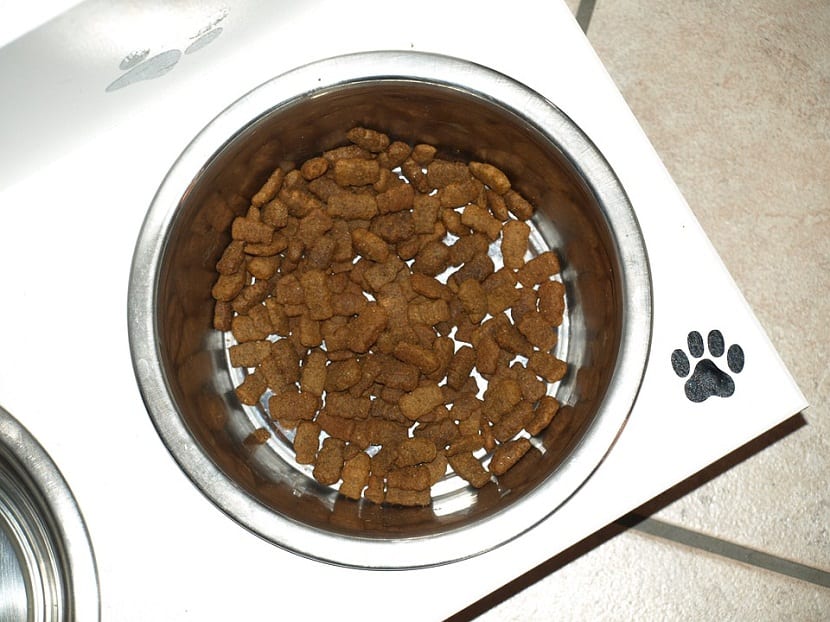
At present, food allergies constitute about 10% of the total amount of allergies that occur in dogs. This is the third most common cause after atopic dermatitis and flea bite.
Food or additive allergies account for about 20% of the causes of scratching and itching in dogs.
Food allergy or intolerance?

This type of allergies usually affect dogs or cats equally. But unlike atopic dermatitis, there is no specific relationship between food allergies and different races.
These allergies harm both males and females equally, regardless of whether they are sterilized or not and can appear from five months of age. There is a difference that we have to make between what is food intolerance and food allergies.
For example, if we feed our dog chicken and after a while he vomits it up and also has diarrhea and we give him chicken one more time and the exact same thing happens again, then this means that our pet has a case of intolerance. On the other hand, if we feed him chicken and in this case it suits him well and he does not have vomiting or diarrhea, but he has itchy legs, ears or chest, this means that our pet has a food allergy.
Brianda food allergies, have very particular symptoms such as skin problems and itching, often related to canine allergies, while food intolerance can usually cause vomiting as well as diarrhea and also does not create any kind of typical allergic response.
The food intolerance of animals is very similar to that of human beings, since we get diarrhea or stomach pain when we eat fried or spicy foods so to speak. But fortunately, both food allergies and intolerance can be eliminated by a diet that does not contain offensive agents.
It has been shown through several studies that some of the ingredients in food are more prone to provoke food allergies that the others.
The most common causes of food allergies that occur in dogs are caused by dairy, lamb, chicken, chicken eggs, wheat, corn, soy, and fish. Therefore, the most common cause comes precisely from the most common components of dog food and this resemblance is not due to chance.
While some proteins may be slightly more antigenic than others, others are very similar in both form and episodes of allergic reactions and possibly related to the quantity supplied.
Symptoms of food allergies
One of the main symptoms of food allergies It is the itching or itching that especially affects places such as the face, ears, hooves, front legs, the area around the anus and the armpits. In addition, these symptoms can include periodic or chronic ear infections, hair loss or baldness in the coat, excessive scratching, hot spots and skin infections that are caused by the use of antibiotics, which appear again after stopping its administration.
There is evidence that dogs that have allergies to certain foods and in some cases they can present a greater frequency in the movements of the intestine. In addition, there have been a few studies that indicate that dogs that are not allergic have about 1,5 defecations a day, on the other hand, dogs that have food allergies can 3 or even more times a day.
It is very difficult to differentiate between a dog that suffers from allergies for some food and another that suffers from atopy or another kind of allergy based only on physical signs.
However, there are some signs that increase suspicions that what our pet is suffering from is an allergy. One of these are the frequent ear problems, which may be associated with an infection caused by a fungus.
Symptoms of food allergies

Another of the signs that appear are the moderate or chronic skin problems, especially if it is a young dog. A third symptom is, if we notice that our dog suffers from allergies throughout the year or also if these signs appear in the winter season.
Also, if you have frequent itching all over your skin and does not respond to any kind of treatment containing steroids, then this may also be a sign of a food allergy.
Because many other problems can cause very similar symptoms and that in many cases our pets suffer more problems than just food allergies, therefore it is essential that we can identify and at the same time correctly treat other problems before submitting to our pet to a tests to rule out a food allergy.
Flea bite allergies, atopy, sarcotic mange, hypersensitivity caused by parasites found within the intestine, bacterial and yeast infections, can all lead to symptoms very similar to food allergies.
A fairly wide variety of these diets have existed in supermarkets for quite some time. Consulting with the vet can be an excellent option in these cases, since a specialist can offer us better help to offer our dog a quality diet.
Similarly, we can find special diets that have both carbohydrates and protein that break down into small molecular parts, thus causing an allergic reaction to be totally neutralized.
This class of diets are known by the name of hydrolyzed protein diets. Homemade diets are often used for these cases, as each ingredient can be controlled very carefully.
Regardless of the diet we use, the most important thing is that it must be the only thing the dog can ingest for the next 12 weeks. This means that we cannot give you any type of medicine that has a flavor, neither raw meat nor toys with food flavors, all of this is definitely prohibited while that time elapses. We will only give our dog his specialized food and his water.
If we want to give our pet some kind of dog biscuit, snacks or treats, it must be based on the food that we are providing in the diet.
As well we must have absolute control of the access that the dog may have to other foods and garbage, in this way we will be able to record any incident that is related to this problem for veterinary control.
In general, veterinarians usually recommend this kind of specialized diet for at least three weeks, however, new studies indicate that in dogs that suffer from these allergies and have been applied this diet, about 26% of them responded positively after the 21st, although most of these responded at the end of the 12-week period.
If our pet has a significant decrease or complete elimination of symptoms, then we can give him his normal food again. This is known as the Provocation Test and it is essential for us to confirm the diagnosis. In case the symptoms appear once again after starting the normal diet, then the suspicion of food allergy is confirmed. If, on the other hand, there is no change in symptoms, but there is still a suspicion of a food allergy, a new food can be added to your meal.
This is one of the best methods out there so that we can know if our dog suffers from a food allergy and what causes said allergy.
Treatments

The vet is the one who indisputably must provide appropriate treatment based on the type of food the dog eats and then the causative elements are completely eliminated from the diet.
A remedy that we can use, but in the short term, is give antihistamines, fatty acids, and steroidsHowever, the best solution is to completely eradicate the harmful agents in the dog's diet.
If we make the decision to feed our dog a homemade diet, we can periodically test the animal by adding new ingredients to be able to pinpoint which ingredients are causing food allergies.
It is very important that home-made diets are balanced and contain the right amount of each of their nutrients. Long-term home diets have to be developed only by a veterinary nutritionist.
We must bear in mind that some dogs with food allergies they can also develop allergies if food is provided for a long period of time.
If the symptoms return again, it is best to take our pet to the vet.